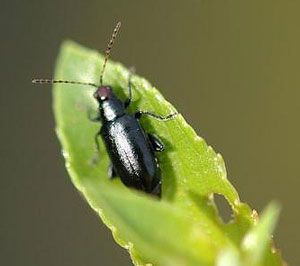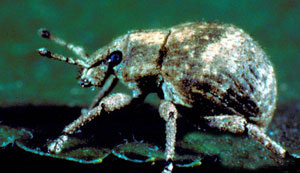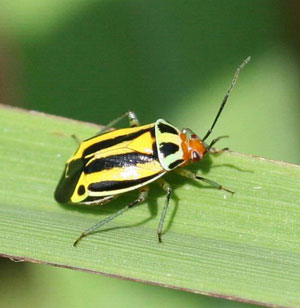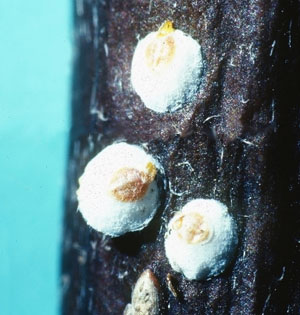Leaf Feeders

Brian Kunkel, University of Delaware, Bugwood.org
Redheaded flea beetle adults are 1/4 inch long with a black body and red head (but it can be difficult to see). They have large femurs on their back legs that allow them to hop, as the name implies. Larvae are soil-based, have a creamy color and can be up to 1/2 inch long. This pest overwinters as eggs in the soil, and larvae hatch out to feed in the root zone, before pupating to emerge as adults. In Delaware and Maryland this first group of adults emerges when Southern magnolia is in bloom. A second generation occurs later in the summer. Adults feed on leaves causing extensive shot-hole damage.

University of Georgia , University of Georgia, Bugwood.org
Two-banded Japanese weevil adults are about 1/4 inch long and pear shaped. Unlike other weevils, which have long snouts, this weevil has a stout, short snout. Adults have a mottled appearance, with grey and brown blotches giving them an almost camouflage-like appearance. There are two distinct bands that form across the back of the elytra. Larvae look like other weevils -- small, white, and legless. The adults feed along the edges of leaves, making notches at first, then tattered edges. In heavy infestations, whole leaves may be consumed. They overwinter as eggs, larvae, and adults. Overwintering adults resume feeding in May and produce the next generation with new adults emerging in June-July.
Sap Feeders

Johnny N. Dell, Bugwood.org
Four-lined plant bug adults are between 1/4-1/3 inch long, have an orange head and yellowish body with four black stripes running down the back. The nymphs are red to red-orange with black dots. There is one generation per year, with feeding and growing occurring in May and June. As they feed, four-lined plant bugs create circular brown-black spots. The spots are about 1/16-inch wide and can merge together to create a blotchy appearance that resembles a disease issue. The damaged spots can also dry and fall out of the surrounding healthy tissue, leaving a hole behind.

.A. Davidson, Univ. Md, College Pk, Bugwood.org
White peach scale adult females look like tiny fried eggs on twigs and branches. The outer covering is whitish and there is a central or offset orange/yellow dot (which is the actual scale herself). Males are narrow in comparison and have a white, fluffy appearance. Depending on the climate, there can be between 2-4 generations per year. In North Carolina there are three peaks of crawler activity- early May, mid-July, and early September. Heavy infestations can lead to leaf yellowing, dieback, and possible mortality of the plant.